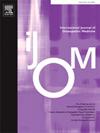Relationship of forward head posture with cervical muscle thickness and neck pain-related disability among young adults: a cross-sectional study
IF 1.5
4区 医学
Q2 MEDICINE, GENERAL & INTERNAL
引用次数: 0
Abstract
Background
Forward head posture (FHP) is a common postural disorder in patients with neck pain. Despite the intuitive assumption that FHP determines neck pain characteristics, its effect on neck pain and cervical muscle morphology is unclear.
Objectives
To evaluate whether FHP affects cervical muscle morphology and neck pain-related disability among young adults.
Methods
Young adults with chronic neck pain older than 18 years were divided into 2 groups according to craniovertebral angle (CVA): those with FHP (≤49°) and those without. Neck pain severity and disability were evaluated with a numeric rating scale (NRS) and the neck disability index (NDI). Semispinalis capitis and sternocleidomastoid muscle thicknesses were measured via ultrasonography.
Results
Twenty-one females and 31 males were evaluated. The mean ages of those with and without FHP were 19.9 ± 1.1 and 20.0 ± 1.1 years, respectively. The incidence of FHP was significantly greater in females (73 %) (p < 0.001). The normalized muscle thickness for body weight of both the semispinalis capitis and sternocleidomastoid muscle, the NRS pain score, and the NDI were similar between the groups. CVA was weakly negatively correlated with pain but was not correlated with cervical muscle thickness or disability. There was a weak negative correlation between semispinalis capitis muscle thickness and the NRS pain scores.
Conclusions
The frequency of FHP is greater in females. The presence of FHP was unrelated to neck pain severity or cervical muscle thickness and disability in individuals with chronic neck pain. There was a mild negative correlation between extensor muscle thickness and neck pain regardless of FHP.
年轻人头部前倾姿势与颈肌厚度和颈痛相关残疾的关系:一项横断面研究
背景:头部前倾(FHP)是颈痛患者常见的体位障碍。尽管直觉上认为FHP决定了颈部疼痛的特征,但其对颈部疼痛和颈部肌肉形态的影响尚不清楚。目的评价FHP是否影响年轻成人颈部肌肉形态和颈部疼痛相关残疾。方法将年龄在18岁以上的慢性颈痛青年患者根据颅椎角(CVA)分为两组:有FHP(≤49°)组和无FHP组。采用数字评定量表(NRS)和颈部残疾指数(NDI)评估颈部疼痛严重程度和残疾程度。超声测量头半棘肌和胸锁乳突肌厚度。结果女性21例,男性31例。FHP患者和非FHP患者的平均年龄分别为19.9±1.1岁和20.0±1.1岁。FHP在女性中的发病率显著高于男性(73%)(p <;0.001)。两组间头肌半棘肌和胸锁乳突肌体重的归一化肌肉厚度、NRS疼痛评分和NDI相似。CVA与疼痛呈弱负相关,但与颈肌厚度和残疾无关。半棘肌厚度与NRS疼痛评分呈弱负相关。结论FHP在女性中发病率较高。慢性颈痛患者中FHP的存在与颈痛严重程度、颈肌厚度和残疾无关。伸肌厚度与颈部疼痛呈轻度负相关,与FHP无关。
本文章由计算机程序翻译,如有差异,请以英文原文为准。
求助全文
约1分钟内获得全文
求助全文
来源期刊
CiteScore
2.20
自引率
36.80%
发文量
42
审稿时长
3 months
期刊介绍:
The International Journal of Osteopathic Medicine is a peer-reviewed journal that provides for the publication of high quality research articles and review papers that are as broad as the many disciplines that influence and underpin the principles and practice of osteopathic medicine. Particular emphasis is given to basic science research, clinical epidemiology and health social science in relation to osteopathy and neuromusculoskeletal medicine.
The Editorial Board encourages submission of articles based on both quantitative and qualitative research designs. The Editorial Board also aims to provide a forum for discourse and debate on any aspect of osteopathy and neuromusculoskeletal medicine with the aim of critically evaluating existing practices in regard to the diagnosis, treatment and management of patients with neuromusculoskeletal disorders and somatic dysfunction. All manuscripts submitted to the IJOM are subject to a blinded review process. The categories currently available for publication include reports of original research, review papers, commentaries and articles related to clinical practice, including case reports. Further details can be found in the IJOM Instructions for Authors. Manuscripts are accepted for publication with the understanding that no substantial part has been, or will be published elsewhere.

 求助内容:
求助内容: 应助结果提醒方式:
应助结果提醒方式:


